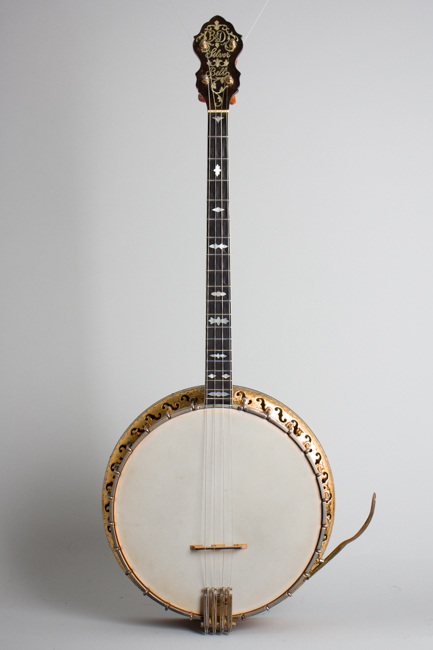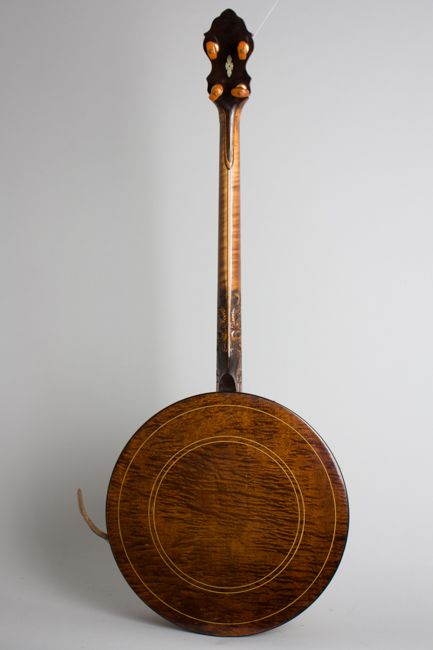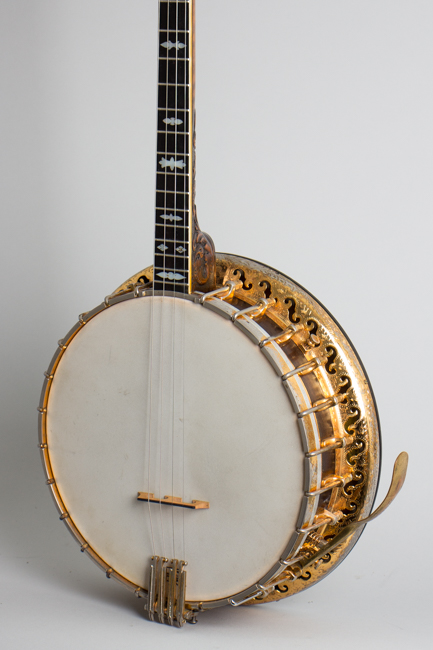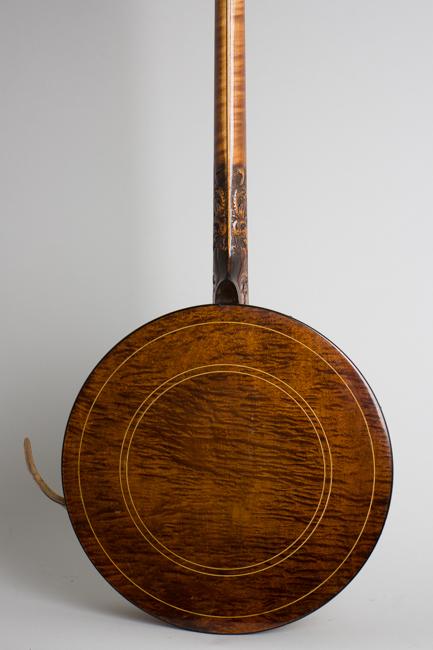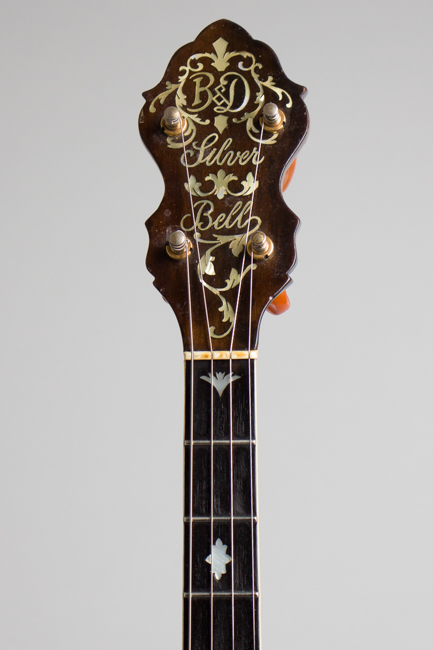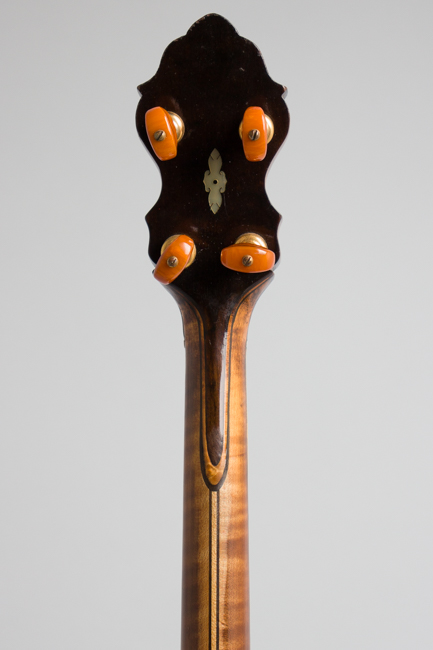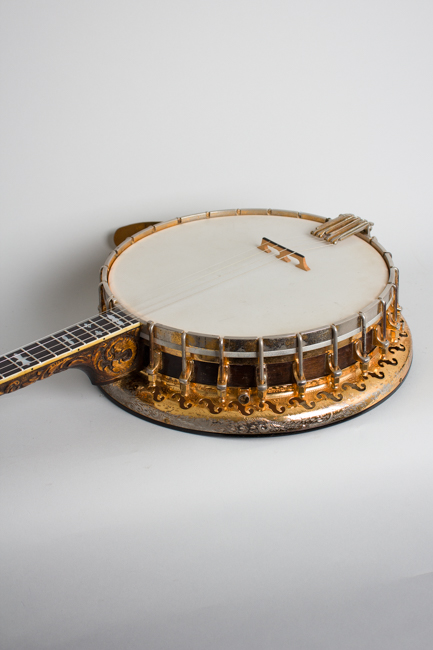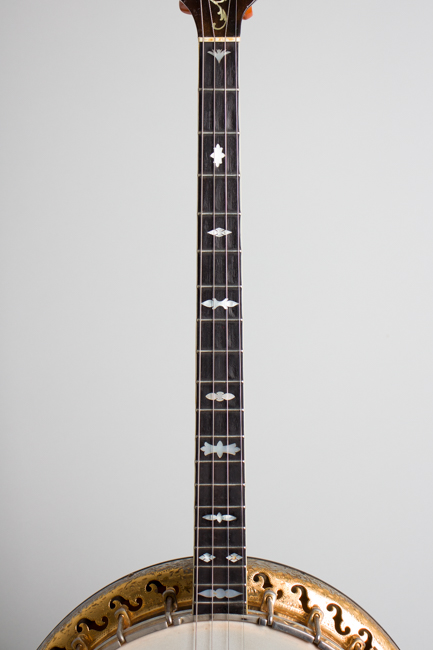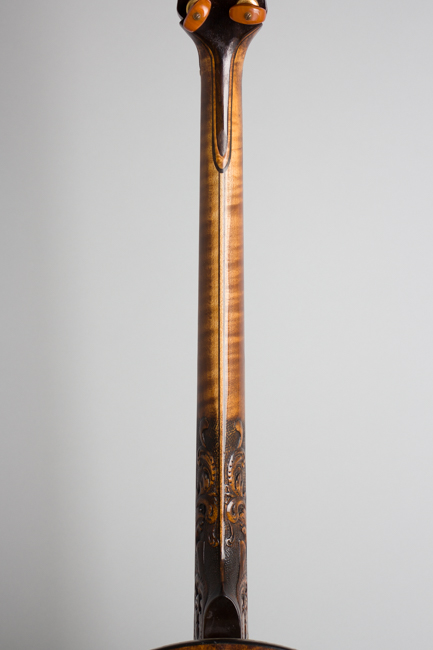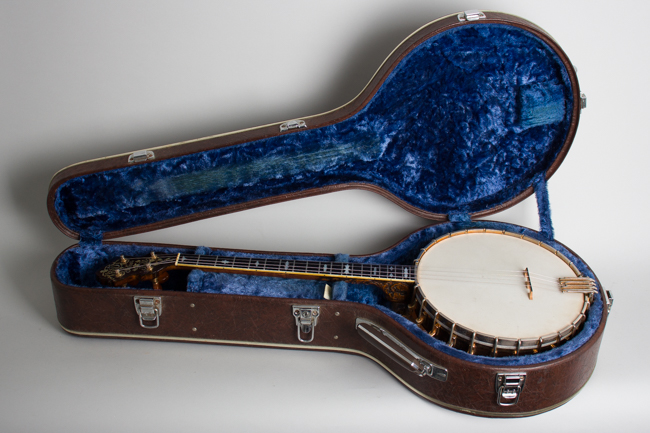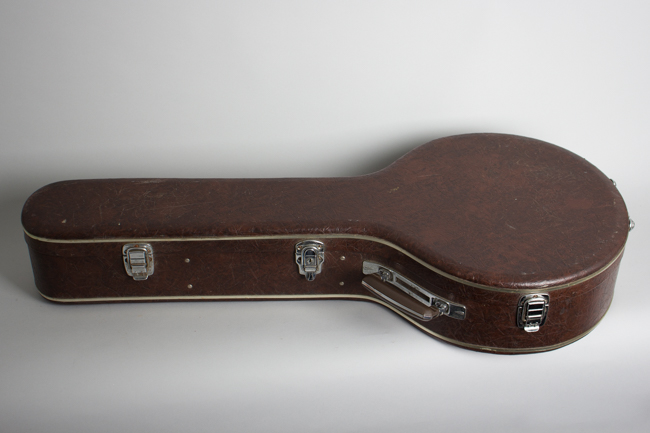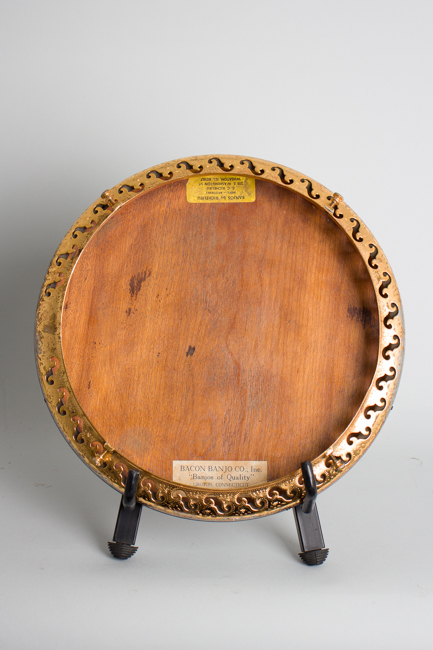Bacon & Day Silver Bell marked Special #4 Tenor Banjo (1927)
This item has been sold.
Item # 10172
Prices subject to change without notice.
Bacon & Day Silver Bell marked Special #4 Model Tenor Banjo (1927), made in Groton CT, serial # 23670, shaded maple finish, laminated maple neck, rim and resonator; ebony fingerboard, brown tolex hard shell case.
This tenor banjo is fancy 19-fret Silver Bell, a nice representative of the Bacon Banjo Company's high-end professional Bacon & Day line. Upper-end Silver Bells were among the fanciest and most expensive (for the period) banjos built. This is a midline model, labeled a #4 Special on the dowel. It was reworked (probably 50 or more years ago) by well known banjo luthier C.C Richelieu, something quite common at the time for 1920's banjos revived for the Dixieland craze. It is likely assembled from parts of different banjos, "Upgraded" as was common at the time.
The Silver Bell models are all very flashy instruments, quite popular in the 1920s and beyond especially among vaudeville and variety players. This gold-plated "#4 Special" is actually LESS fancy than a cataloged Style 4, lacking the bound headstock and engraved hoop listed as features of that model. The unique low-mounted Silver Bell flange IS engraved, and features the trademark f-hole shaped sound holes. The resonator back is dark-finished figured maple, bound in black celluloid with several inlaid rings. The heavy Silver Bell tone ring is the later non-perforated style, and the famous knee mute is present and working. The tailpiece is the original adjustable Oettinger.
The multi-laminate maple neck has delicate shaped pearl inlays in the bound ebony fingerboard, and a carved heel. The laminate headstock (both front and back) has elaborate floral pearl inlay around the "B&D Silver Bell" logo. This one has original pre-war geared Planet tuners that work fine 90+ years along; the buttons are amber catalin typical of the late 1930's.
It is difficult document exactly all work done to the banjo at C.C. Richelieu's shop long ago; he was considered the finest jazz age banjo expert/builder/restorer for many years and rebuilt countless older banjos for continued use in the 60s and 70s. The resonator and neck look to have been oversprayed or possibly fully refinished, while the dowel and rim remain original. The gold plating was certainly redone, as was typical and the banjo was refretted, probably at the same time. Richelieu's shop label is on the resonator back, across from the Bacon label. It reads in part "Banjos by Richelieu; Mfgrs. And Restorers" with the Illinois address. This Tenor has seen quite a bit of use since its visit there, but the Silver Bell series were among the finest banjos ever built and this Special #4 is a lovely example and still a superb instrument.
Overall length is 33 1/2 in. (85.1 cm.), 11 in. (27.9 cm.) diameter head, and 4 in. (10.2 cm.) in depth, measured at side of rim. Scale length is 23 in. (584 mm.). Width of nut is 1 3/16 in. (30 mm.).
This is a nice example of this classic Silverbell model overall, showing a decent amount of wear after 90+ years of use but ready to twang on for many more. As noted it was re-worked decades ago and has been further worn since that time. The finish on the neck and resonator back are certainly Richelieu's work, and appear to be an overspray to the original Bacon varnish rather than a full strip-and-refinish job. The finish overall shows some typical scratches and scuffs, with the spine of the neck worn down to the wood from play.
All hardware is original or at least correct Bacon parts except for three of the screw adjustors on the Oettinger tailpiece; one is original thumbscrew, the others are a mixed bag of random screws. The "spoon" mute pedal is a genuine Bacon part but marked with the 1931 parent date, so is a bit later than the banjo itself. The mute is set up correctly and works exactly as intended. The gold plating overall shows quite a bit wear, especially on the hoop and hooks which are heavily worn through. This is not unusual for an instrument of this age, although Richelieu's gold plate is heavier than most. A previous owner wrote his name on the dowel stick in pen.
The neck is nice and straight, the second set of frets was recently polished out to like-new condition. The ebony fingerboard shows wear, with shallow divots evidence of decades of play. This is a fine sounding and excellent playing Silverbell, not too far off from entering its second century on Earth. It is set up with a plastic head and ebony/bone capped maple bridge and includes a more later HSC, looking to be from the 1970s. Overall Very Good + Condition.
This tenor banjo is fancy 19-fret Silver Bell, a nice representative of the Bacon Banjo Company's high-end professional Bacon & Day line. Upper-end Silver Bells were among the fanciest and most expensive (for the period) banjos built. This is a midline model, labeled a #4 Special on the dowel. It was reworked (probably 50 or more years ago) by well known banjo luthier C.C Richelieu, something quite common at the time for 1920's banjos revived for the Dixieland craze. It is likely assembled from parts of different banjos, "Upgraded" as was common at the time.
The Silver Bell models are all very flashy instruments, quite popular in the 1920s and beyond especially among vaudeville and variety players. This gold-plated "#4 Special" is actually LESS fancy than a cataloged Style 4, lacking the bound headstock and engraved hoop listed as features of that model. The unique low-mounted Silver Bell flange IS engraved, and features the trademark f-hole shaped sound holes. The resonator back is dark-finished figured maple, bound in black celluloid with several inlaid rings. The heavy Silver Bell tone ring is the later non-perforated style, and the famous knee mute is present and working. The tailpiece is the original adjustable Oettinger.
The multi-laminate maple neck has delicate shaped pearl inlays in the bound ebony fingerboard, and a carved heel. The laminate headstock (both front and back) has elaborate floral pearl inlay around the "B&D Silver Bell" logo. This one has original pre-war geared Planet tuners that work fine 90+ years along; the buttons are amber catalin typical of the late 1930's.
It is difficult document exactly all work done to the banjo at C.C. Richelieu's shop long ago; he was considered the finest jazz age banjo expert/builder/restorer for many years and rebuilt countless older banjos for continued use in the 60s and 70s. The resonator and neck look to have been oversprayed or possibly fully refinished, while the dowel and rim remain original. The gold plating was certainly redone, as was typical and the banjo was refretted, probably at the same time. Richelieu's shop label is on the resonator back, across from the Bacon label. It reads in part "Banjos by Richelieu; Mfgrs. And Restorers" with the Illinois address. This Tenor has seen quite a bit of use since its visit there, but the Silver Bell series were among the finest banjos ever built and this Special #4 is a lovely example and still a superb instrument.
Overall length is 33 1/2 in. (85.1 cm.), 11 in. (27.9 cm.) diameter head, and 4 in. (10.2 cm.) in depth, measured at side of rim. Scale length is 23 in. (584 mm.). Width of nut is 1 3/16 in. (30 mm.).
This is a nice example of this classic Silverbell model overall, showing a decent amount of wear after 90+ years of use but ready to twang on for many more. As noted it was re-worked decades ago and has been further worn since that time. The finish on the neck and resonator back are certainly Richelieu's work, and appear to be an overspray to the original Bacon varnish rather than a full strip-and-refinish job. The finish overall shows some typical scratches and scuffs, with the spine of the neck worn down to the wood from play.
All hardware is original or at least correct Bacon parts except for three of the screw adjustors on the Oettinger tailpiece; one is original thumbscrew, the others are a mixed bag of random screws. The "spoon" mute pedal is a genuine Bacon part but marked with the 1931 parent date, so is a bit later than the banjo itself. The mute is set up correctly and works exactly as intended. The gold plating overall shows quite a bit wear, especially on the hoop and hooks which are heavily worn through. This is not unusual for an instrument of this age, although Richelieu's gold plate is heavier than most. A previous owner wrote his name on the dowel stick in pen.
The neck is nice and straight, the second set of frets was recently polished out to like-new condition. The ebony fingerboard shows wear, with shallow divots evidence of decades of play. This is a fine sounding and excellent playing Silverbell, not too far off from entering its second century on Earth. It is set up with a plastic head and ebony/bone capped maple bridge and includes a more later HSC, looking to be from the 1970s. Overall Very Good + Condition.
